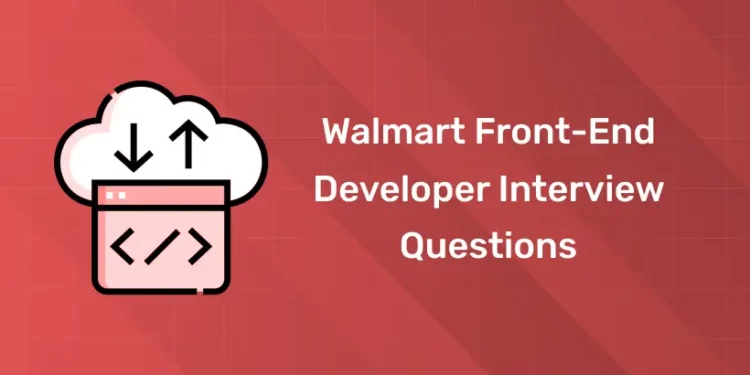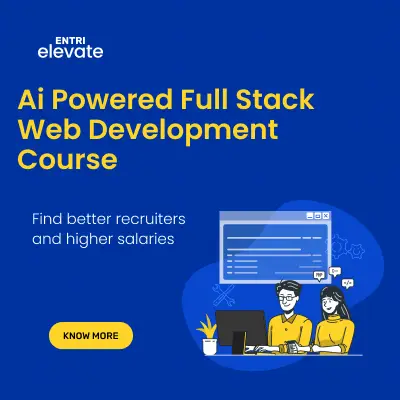Table of Contents
Walmart, one of the world’s largest and most successful retail giants, is known for its innovative digital solutions and customer-focused technologies. As Walmart continues to expand its online presence and enhance its digital platforms, the demand for skilled front-end developers has grown significantly. If you’re aiming to join Walmart as a front-end developer, you’ll need to be well-prepared for their comprehensive interview process, which assesses not only your technical expertise in core web technologies but also your problem-solving abilities and collaboration skills. In this blog, we’ll explore some of the key front-end developer interview questions that can help you prepare effectively, ensuring you’re ready to showcase your strengths and land a role with this global leader.
Learn Full Stack Development with expert mentors! Get Free Demo Here!
Introduction
Walmart Inc. is a multinational retail corporation and one of the world’s largest retailers, founded by Sam Walton in 1962 and headquartered in Bentonville, Arkansas. With over 10,500 stores in 24 countries and a strong online presence, Walmart generates more than $600 billion in annual revenue and employs around 2.3 million people globally. Known for its low-cost pricing strategy and high-volume sales, Walmart offers a wide range of products, from groceries to electronics, and has expanded into e-commerce to compete with companies like Amazon.
Walmart emphasizes innovation, using advanced technologies such as AI and data analytics to enhance operations and customer experience. Committed to sustainability and social responsibility, Walmart aims to achieve zero waste and 100% renewable energy usage across its operations. With initiatives like Walmart+, Flipkart in India, and Walmart Connect, the company continues to lead in both physical retail and digital commerce while upholding a customer-first approach and a focus on diversity, community, and operational efficiency.
Why Join in Walmart?
Joining Walmart as a front-end developer can be a great career choice due to the following reasons:
1. Global Impact
Walmart is one of the largest retailers in the world, serving millions of customers daily. As a front-end developer, you’ll have the opportunity to work on high-traffic applications that impact a vast customer base globally.
2. Innovative Technology
Walmart invests heavily in technology and innovation. You’ll work with cutting-edge tools, frameworks, and platforms to build dynamic, user-friendly, and scalable web applications. This will help you sharpen your skills and stay updated with the latest tech trends.
3. Challenging Projects
Walmart’s front-end development involves working on complex projects that require problem-solving, creativity, and collaboration. You’ll contribute to optimizing the user experience across various devices and platforms, pushing your limits as a developer.
4. Career Growth Opportunities
With Walmart’s global reach and multiple departments, there are various career paths to explore within the company. You’ll have access to mentorship programs, learning opportunities, and the chance to advance to leadership or senior technical roles.
5. Strong Organizational Support
Walmart promotes a collaborative environment with cross-functional teams where you can work closely with UX/UI designers, backend developers, and product managers. This holistic work culture fosters continuous learning and teamwork.
6. Competitive Compensation and Benefits
Walmart offers competitive salaries and comprehensive benefits packages, including health insurance, retirement plans, employee discounts, and more. This adds financial stability while ensuring work-life balance.
7. Focus on Diversity and Inclusion
Walmart is committed to building a diverse and inclusive workforce, where employees from different backgrounds feel valued and empowered to contribute. As a front-end developer, you’ll be part of a supportive community that encourages diversity.
8. Social and Environmental Responsibility
Walmart actively engages in corporate social responsibility, including sustainability initiatives and community outreach. If you’re passionate about making a positive impact beyond just your work, Walmart provides a platform for you to get involved.
Walmart Interview Preparation Tips for Front-end Developer
Here are some essential tips to help you prepare for a Walmart front-end developer interview:
1. Brush Up on Core Front-end Technologies
- HTML/CSS: Ensure a solid understanding of HTML5 and CSS3, including concepts like the box model, positioning, Flexbox, Grid, and responsive design.
- JavaScript: Master JavaScript fundamentals, including ES6+ features like arrow functions, promises, async/await, destructuring, and spread/rest operators.
- DOM Manipulation: Know how to interact with the DOM, handle events, and manipulate elements dynamically using JavaScript.
2. Learn Popular Front-end Frameworks/Libraries
- React.js: Walmart often uses React.js for its web applications. Be prepared to discuss hooks, components, state management, lifecycle methods, and context API.
- Redux: Understand Redux for managing application state and how it integrates with React.
- Other Frameworks: Familiarize yourself with other popular front-end libraries like Angular or Vue.js, though React is often a key focus.
3. Master Version Control (Git)
- Understand Git commands like branching, merging, pull requests, and resolving merge conflicts. Collaboration with other developers in a large company like Walmart often involves efficient use of Git.
4. Responsive and Accessible Design
- Know how to build responsive layouts using media queries and frameworks like Bootstrap or Material UI.
- Familiarize yourself with web accessibility standards (WCAG), ARIA roles, and best practices for making web applications accessible to all users.
5. Understand Web Performance Optimization
- Be ready to discuss techniques for improving web performance, such as lazy loading, image optimization, caching, and minimizing bundle sizes.
- Tools like Lighthouse and Webpack can also be important topics.
6. Work on Cross-browser Compatibility
- Ensure you can handle cross-browser compatibility issues and are familiar with modern web tools like Autoprefixer to make applications work on different browsers and devices.
7. Focus on Problem-solving and Data Structures
- Walmart interviews often focus on problem-solving skills. Practice algorithmic challenges related to arrays, strings, objects, recursion, and sorting algorithms.
- Be comfortable solving coding problems on platforms like LeetCode, HackerRank, or CodeSignal.
8. Prepare for Behavioral Interviews
- Walmart values cultural fit. Be ready to answer behavioral questions that assess how you handle teamwork, conflict resolution, and your approach to deadlines and feedback.
- Use the STAR method (Situation, Task, Action, Result) to structure your answers to behavioral questions.
9. Understand Agile and DevOps Practices
- Be familiar with Agile methodologies and how front-end developers fit into an Agile team.
- Basic knowledge of CI/CD pipelines (Continuous Integration/Continuous Deployment) and tools like Jenkins can also help.
10. Study Walmart’s Products and Technology Stack
- Research Walmart’s web presence, mobile apps, and other customer-facing platforms. Understand their design language, performance, and user experience.
- Learn about the technologies Walmart uses and how they are integrating innovative solutions in their customer experiences.
Learn Full Stack Development with expert mentors! Get Free Demo Here!
Basic Walmart Front-end Developer Interview Questions and Answers
Here are some basic Walmart Front-end Developer interview questions and answers that can help in your preparation:
1. What is the role of a front-end developer?
Answer: A front-end developer is responsible for implementing the visual elements users see and interact with in a web application. They use HTML, CSS, and JavaScript to create user interfaces and ensure a seamless user experience. Their role also includes optimizing web pages for speed, cross-browser compatibility, and responsiveness.
2. What are the key differences between div and span?
Answer:
div: A block-level element used for structuring content. It takes up the full width available and starts on a new line.span: An inline element used to style parts of a text or inline content without breaking the flow of text.
3. Explain the box model in CSS.
Answer: The CSS box model consists of four parts:
- Content: The actual content of the element (text, image, etc.).
- Padding: Space around the content, inside the element’s border.
- Border: A border surrounding the padding and content.
- Margin: Space outside the border, separating the element from others.
4. What are semantic HTML elements?
Answer: Semantic HTML elements clearly describe their meaning to both the browser and the developer. Examples include:
<article>,<header>,<footer>,<section>,<nav>, etc. They improve accessibility and SEO by providing better structure and meaning to the web page.
5. What are the differences between == and === in JavaScript?
Answer:
==(loose equality): Compares two values after converting them to the same type (type coercion).===(strict equality): Compares two values without type conversion. Both the value and the type must be the same for it to returntrue.
6. Explain the concept of closures in JavaScript.
Answer: A closure is a function that retains access to its lexical scope even when executed outside of its original scope. This allows the function to remember and access variables from the outer scope in which it was created, even after that scope has closed.
7. What is the difference between var, let, and const in JavaScript?
Answer:
var: Function-scoped, can be re-declared and updated. It is hoisted.let: Block-scoped, can be updated but not re-declared in the same scope. It is hoisted but not initialized.const: Block-scoped, cannot be updated or re-declared. Useful for declaring constants.
8. What is responsive web design?
Answer: Responsive web design ensures that a website’s layout adjusts to different screen sizes and devices. It is typically achieved using flexible grids, images, and CSS media queries. This approach enhances user experience across desktops, tablets, and smartphones.
9. What are media queries in CSS?
Answer: Media queries allow you to apply different styles based on the device’s characteristics such as screen width, height, orientation, and resolution. It is a core feature of responsive design.
10. How do you optimize the performance of a website?
Answer: Some common techniques to improve website performance are:
- Minifying CSS, JavaScript, and HTML files.
- Compressing images and using modern formats like WebP.
- Implementing lazy loading for images and assets.
- Reducing the number of HTTP requests.
- Using browser caching.
- Optimizing code and removing unused CSS and JavaScript.
- Utilizing content delivery networks (CDNs).
Learn Full Stack Development with expert mentors! Get Free Demo Here!
Advanced Walmart Front-end Developer Interview Questions and Answers
1: Which of the following is a JavaScript framework/library?
Here are advanced Walmart Front-end Developer interview questions and answers to help you with your preparation:
1. Explain the concept of Virtual DOM in React.
Answer: The Virtual DOM is a lightweight copy of the real DOM. When a React component’s state or props change, the Virtual DOM is updated. React then compares this updated Virtual DOM with the previous version (using a process called “reconciliation”) to identify the changes, and only those changes are updated in the actual DOM. This makes the rendering process more efficient.
2. What is event delegation in JavaScript?
Answer: Event delegation is a technique in JavaScript where a single event listener is added to a parent element, which listens for events on its child elements. When an event is triggered, it propagates (bubbles up) to the parent, allowing it to handle events for all its descendants. This reduces the number of event listeners and enhances performance.
3. What is server-side rendering (SSR), and how does it differ from client-side rendering (CSR)?
Answer:
- SSR (Server-Side Rendering): The HTML for a web page is generated on the server and sent to the browser. This approach improves SEO and provides faster initial loading time.
- CSR (Client-Side Rendering): JavaScript on the client (browser) is responsible for rendering the page. Content is fetched via API calls, and the browser dynamically builds the page.
4. What are Web Components, and why are they important?
Answer: Web Components are a set of standardized APIs allowing developers to create reusable, encapsulated custom elements. They include:
- Custom Elements: Define new HTML tags.
- Shadow DOM: Encapsulates styles and markup to avoid conflicts with the global scope.
- HTML Templates: Define reusable HTML structures. Web Components promote code reusability, maintainability, and better encapsulation.
5. What is the difference between null and undefined in JavaScript?
Answer:
undefined: A variable is declared but not initialized.null: A variable is explicitly assigned to represent “no value.”
6. Explain the difference between synchronous and asynchronous JavaScript.
Answer:
- Synchronous JavaScript: Code is executed line by line. Each operation must complete before the next one starts.
- Asynchronous JavaScript: Code allows for non-blocking operations, meaning certain tasks (like fetching data) can happen while other tasks continue. Promises and async/await are used for handling asynchronous operations.
7. What are the key principles of Progressive Web Apps (PWAs)?
Answer:
- Responsive: Works on any screen size.
- Connectivity independent: Can work offline or in poor network conditions.
- App-like: Feels like a native app with app-style interactions and navigation.
- Fresh: Always up-to-date with service workers.
- Safe: Uses HTTPS for secure communication.
- Installable: Can be installed on the user’s device.
8. What is a Service Worker, and how does it work in PWAs?
Answer: A Service Worker is a script that runs in the background, separate from the web page, enabling features like background sync, push notifications, and offline functionality. It intercepts network requests and can serve cached assets to ensure the app works offline.
9. Explain the difference between forEach(), map(), and filter() in JavaScript.
Answer:
forEach(): Iterates over an array, executing a callback for each element, but does not return anything.map(): Iterates over an array, applies a transformation function to each element, and returns a new array.filter(): Iterates over an array, applies a condition, and returns a new array with elements that pass the condition.
10. What is lazy loading, and why is it important?
Answer: Lazy loading is a design pattern that delays loading non-essential resources (e.g., images, scripts) until they are needed, improving initial load times. It helps optimize performance, especially in large applications, by loading content only when it becomes visible or required.
11. What are CSS preprocessors, and why are they used?
Answer: CSS preprocessors like Sass and LESS allow developers to use features not available in standard CSS, such as variables, nesting, and mixins. These preprocessors make CSS more maintainable and modular by allowing code reuse and organization.
12. Explain the difference between let and const regarding scope and reassignment.
Answer:
let: Block-scoped and can be reassigned but not re-declared within the same scope.const: Block-scoped, cannot be reassigned or re-declared. However, for objects or arrays, the content can still be mutated.
13. What is the difference between throttling and debouncing in JavaScript?
Answer:
- Throttling: Limits the execution of a function to once per specified time interval, regardless of how many times it’s triggered.
- Debouncing: Delays the execution of a function until after a certain time has passed since the last trigger.
14. What are HTTP/2 and its key benefits over HTTP/1.1?
Answer:
- Multiplexing: Allows multiple requests to be sent for a single connection.
- Header Compression: Reduces overhead by compressing HTTP headers.
- Server Push: Servers can send resources to the client before they are requested.
15. What are higher-order components (HOCs) in React?
Answer: Higher-Order Components (HOCs) are functions that take a component and return a new component with additional props or behaviors. They are used for reusing component logic across multiple components.
16. What is memoization, and how does it improve performance in React?
Answer: Memoization is an optimization technique that stores the results of expensive function calls and returns the cached result when the same inputs occur again. In React, React.memo can be used to prevent unnecessary re-renders when component props haven’t changed.
17. Explain Content Security Policy (CSP).
Answer: CSP is a security feature that helps prevent cross-site scripting (XSS) and data injection attacks by allowing developers to specify which content sources are trusted. It is implemented via HTTP headers and restricts the resources (scripts, styles, etc.) that a page can load.
18. What is tree shaking in JavaScript?
Answer: Tree shaking is a process of removing unused code from a JavaScript bundle. This is especially useful in modern JavaScript bundlers like Webpack, which can analyze dependencies and eliminate dead code, reducing the size of the final bundle.
19. Explain the difference between Stateful and Stateless components in React.
Answer:
- Stateful components: These manage their own state internally and can change over time.
- Stateless components: These are functional components that rely on props and do not maintain or manage their own state.
20. What is the use of Webpack in front-end development?
Answer: Webpack is a module bundler that takes modules with dependencies and bundles them into static assets. It helps manage and optimize JavaScript, CSS, and other assets. Features like code splitting, tree shaking, and hot module replacement (HMR) make it highly effective in modern front-end development.
Learn Full Stack Development with expert mentors! Get Free Demo Here!
🚀 Start Coding Today! Enroll Now with Easy EMI Options. 💳✨
Get Hired as a Full-Stack Developer: Master the Skills Employers Are Looking For!
Start Learning With EMI Payment OptionsWalmart Front-end Developer Technical Interview Questions and Answers
Here are some technical coding questions you might encounter during a Walmart Front-end Developer interview, along with answers:
1. Reverse a String Without Using Built-In Functions (JavaScript)
Question: Write a function that reverses a string without using the built-in reverse() method.
Answer:
2. Check if a String is a Palindrome (JavaScript)
Question: Write a function that checks if a given string is a palindrome.
Answer:
3. Find the Largest Element in an Array (JavaScript)
Question: Write a function that returns the largest element in an array.
Answer:
4. Sum of Digits of a Number (JavaScript)
Question: Write a function to find the sum of digits of a given number.
Answer:
5. Find the Missing Number in an Array (JavaScript)
Question: Given an array containing n distinct numbers taken from the range 1 to n+1, write a function to find the missing number.
Answer:
6. Flatten an Array (JavaScript)
Question: Write a function that flattens a nested array.
Answer:
7. Fibonacci Sequence Using Recursion (JavaScript)
Question: Write a recursive function to generate the nth Fibonacci number.
Answer:
8. Find the First Non-Repeating Character in a String (JavaScript)
Question: Write a function to find the first non-repeating character in a string.
Answer:
9. Sort an Array of Strings by Length (JavaScript)
Question: Write a function that sorts an array of strings by length in ascending order.
Answer:
10. Debounce Function (JavaScript)
Question: Write a debounce function that limits the rate at which a function can fire.
Answer:
11. Count the Occurrences of Characters in a String (JavaScript)
Question: Write a function to count the occurrences of each character in a string.
Answer:
12. Implementing a Simple Promise (JavaScript)
Question: Write a simple implementation of a Promise that resolves after 2 seconds.
Answer:
13. Sum of Two Numbers in an Array That Equals a Target (JavaScript)
Question: Write a function that finds two numbers in an array that add up to a target value.
Answer:











